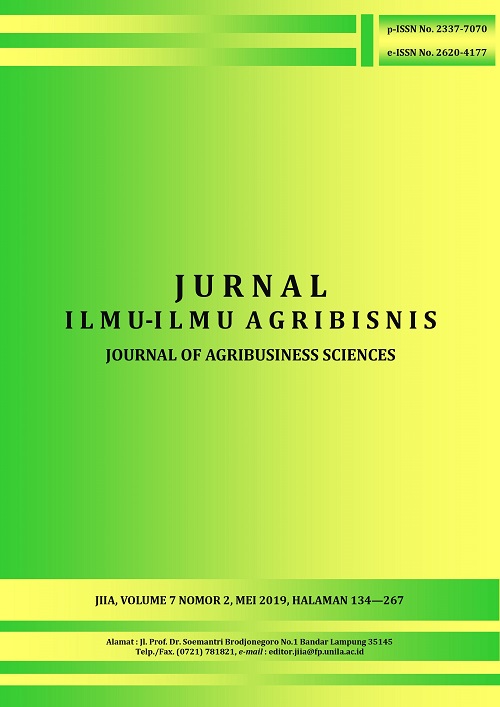POLA KONSUMSI TAHU DAN TEMPE PADA KELUARGA PRASEJAHTERA (KASUS DI KELURAHAN WAY LUNIK KECAMATAN PANJANG BANDAR LAMPUNG)
DOI:
https://doi.org/10.23960/jiia.v7i2.3377 Abstract View: 817
Abstract View: 817
Abstract
This research aimed to know the pattern of tofu and tempe consumption, and factors that affected tofu and tempe consumption. The method used in this research was survay in which location was chosen purposively at Way Lunik village, Panjang Subdistrict, Bandar Lampung. This research employed 60 sample families, in which housewives saved as respondents. The data were taken in August 2017 and analyzed quantitatively by multiple linier regression and descriptive method. The result showed that the average of total consumption of tofu by underprivilage families was 2,017.50 grams/week or 288.21 grams/day, while for tempe was 1,296.50 grams/week or 185.21 grams/day. Underprivilage families ate tofu and tempe very often. Consumption purposes of tofu and tempe was for pleasure and habit in which processing use deep frying and being sauteed. Underprivilage families consumpted tofu and tempe by buying. Factors that affected on tofu consumption by underprivilage families were tofu price, chicken egg price, and number of family members; while factors that affected on tempe consumption by underprivilage families were salted fish price, chicken egg price, family income and the number of family members.
Key words: consumption pattern, tempe, tofu, underprivilage families
Downloads
Downloads
Published
How to Cite
Issue
Section
License
Authors who publish with this journal agree to the following terms:
Authors retain copyright and grant the journal right of first publication with the work simultaneously licensed under a Creative Commons Attribution License that allows others to share the work with an acknowledgement of the work's authorship and initial publication in this journal.
Authors are able to enter into separate, additional contractual arrangements for the non-exclusive distribution of the journal's published version of the work (e.g., post it to an institutional repository or publish it in a book), with an acknowledgement of its initial publication in this journal.
Authors are permitted and encouraged to post their work online (e.g., in institutional repositories or on their website) prior to and during the submission process, as it can lead to productive exchanges, as well as earlier and greater citation of published work (See The Effect of Open Access).














